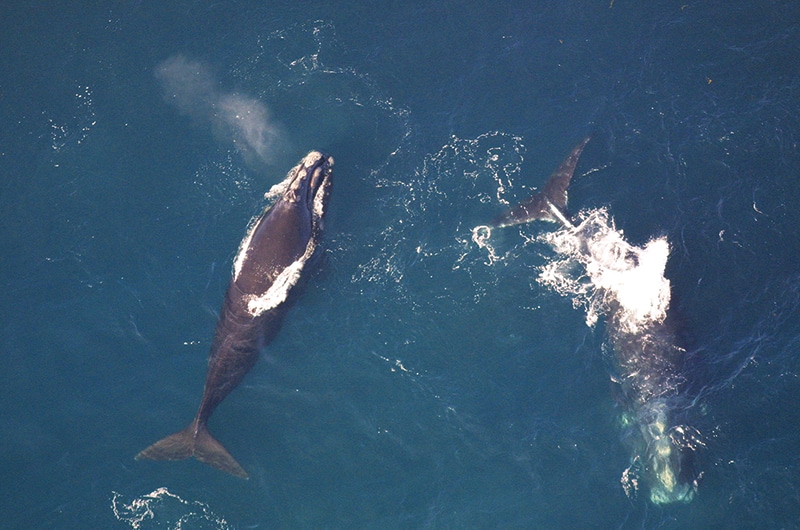Dr. Sarah Treanor Bois
Director of Research & Education at the Linda Loring Nature Foundation
Nantucket is steeped in the history of whaling. Even our school sports teams are The Whalers. We sometimes struggle with that history and how to represent that legacy today. The Nantucket Historical Association, in particular, has recently added a focus on whale ecology and conservation among the displays of harpoons and scrimshaw.
North Atlantic right whales were one of the species previously sought after on Nantucket that are now much in the news. These large baleen whales (Eubalaena glacialis) can be up to 56 feet long and weigh up to 70 tons. In fact, they were called “Right Whales” because they were the right whale to harvest. Their high blubber content made them float when they were killed, and they produced high yields of valuable whale oil.

During the early years of colonial whaling, most of the hunting was done from shore. The whales at that time were relatively abundant and frequent enough that a spotter could see whales from the beach. After several shouts from the spotter, small boats would be launched from shore. From here, whales were harpooned and followed until death. The carcass would be towed back to shore, where the whale would be processed for meat, blubber, and the prized oil.
Despite the seemingly primitive and labor-intensive means of hunting, the right whale was eventually hunted out of the waters surrounding Nantucket, so they were no longer a reliable source of whale oil; a precious commodity at the time. As whale ships began going further afield (or rather, a-sea) to hunt whales, their main prey switched to sperm whales, a much larger species with, thus, much more oil to harvest.
Today, many whale species are still suffering the consequences of the heyday of whaling. It is the North Atlantic right whales, however, that are the closest to extinction. According to the Center for Coastal Studies (CCS) Right Whale Research Program, the current population is estimated to be just 411 and in decline, primarily due to high mortality and low calving. The principal causes of current mortality are ship strike and entanglement.
More than 80 percent of right whales carry scars that indicate that they have been entangled in fishing lines, and nearly 60 percent of those are entangled more than once. Not all entanglements drown whales. Some prevent a whale from feeding, increase the energy a whale needs to swim and feed, and cause pain and stress to the animal, which weaken it. Biologists believe that the additional stress of entanglement is one of the reasons that females are calving less often; females used to have calves every 3 to 5 years, and now are having calves every 6 to 10 years.
In 2017 and 2018, 21 right whale deaths were confirmed and documented. Low reproductive rates continue to contribute to the slow recovery of this species: there were five births in 2017 and none recorded for 2018. In 2019, seven calves have been confirmed, of which three were spotted in Cape Cod Bay.
The whales typically arrive to feed in Cape Cod Bay in late winter and leave by the end of April, along an annual migratory path that stretches from Florida to Canada. This year, however, they’ve been hanging on later into the season, with whales still being picked up at the end of May.
Work by CCS last year found right whales in mid-November, a time of year not known for this species in Cape Cod. In response, the National Oceanic and Atmospheric Administration (NOAA) issued an alert for vessels to slow down and maintain lookouts.
Charles “Stormy” Mayo, Director of the CCS’s Right Whale Ecology Program, states that while the number of North Atlantic right whales is increasing in Cape Cod Bay, the total number of whales is still in decline.
Mayo and colleagues from several other research organizations are working with state and federal agencies to determine how best to manage and protect the remaining population.
So far, CCS has confirmed 267 individual right whales seen by either plane or boat for the current season, making that roughly 65 percent of the estimated total population. Considering the complete range of the whales’ migration along the East Coast, the concentration in the relatively small area of Cape Cod Bay is “remarkable,” Mayo has said.
Last week, new research from the journal Oceanography came out with findings that connect recent changes in the movement of North Atlantic right whales to decreased food availability and rising temperatures in Gulf of Maine’s deep waters. Right whales have been showing up in unexpected places in recent years, putting the endangered species at increased risk.
This misalignment between conservation measures and the whales’ current behavior makes them much more vulnerable to lethal encounters with ships and fishing gear. However, the researchers believe that the strong connection between water temperature, the primary whale food (a tiny zooplankton, Calanus), and right whales makes it possible to predict where new right whale habitats develop, and to plan accordingly.
In late April, a group of approximately 60 fishermen, scientists, conservationists, and state and federal officials gathered to discuss ways to further reduce serious injury and mortality of endangered North Atlantic right whales caused by trap/pot fishing gear. The Atlantic Large Whale Take Reduction Team was able to reach nearly unanimous consensus on right whale survival measures.
The measures in the package include reductions in vertical buoy lines as well as gear modifications to reduce the strength at which lines will break. Reduced breaking strength lines would allow entangled whales to more easily break free of gear.
Additionally, an expansion of gear-marking to create larger and more frequent marks on U.S. lobster trap/pot buoy lines throughout U.S. East Coast waters was supported by most team members. This expansion should improve the ability of whale scientists and managers to better determine the source of gear seen on or retrieved from endangered whales.
Hopefully, with these measures in place and continued research, right whale populations will have a chance to improve.
To learn more about North Atlantic right whales in our area, check out the Center for Coastal Studies right whale research field notes on their website: coastalstudies.org/right-whale-research/field-notes/ — researchers post regular reports and blog posts about their findings.
Boaters, kayakers, paddle-boarders, swimmers, and light aircraft and drone pilots are reminded that it is illegal to approach North Atlantic right whales within 500 yards (1500 feet) without a Federal Research Permit. However, the right whales often feed very close to shore, offering whale watchers on land unbeatable views of one of the rarest of the marine mammals.


